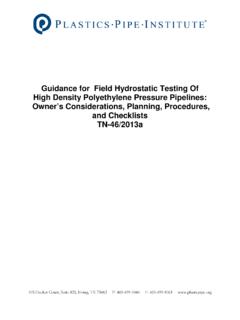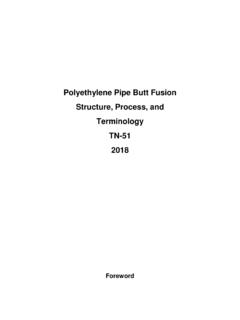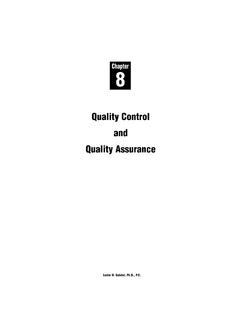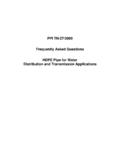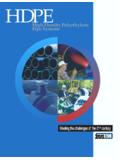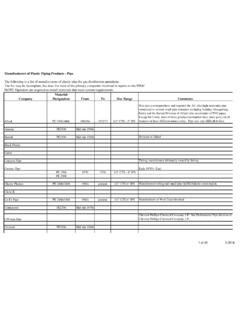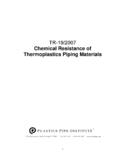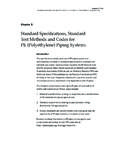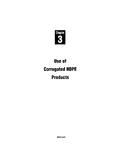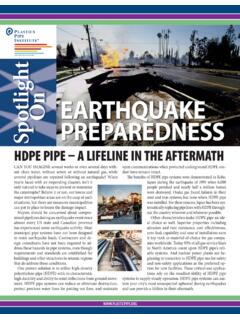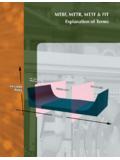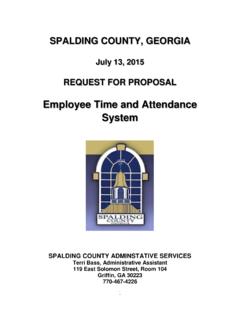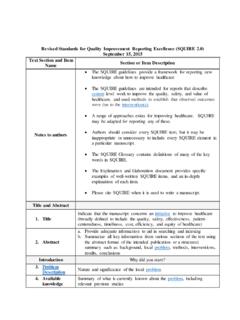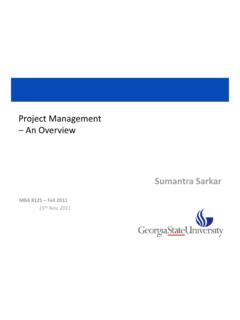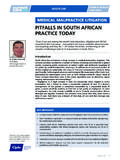Transcription of TN-7 Nature of Hydrostatic Stress Rupture Curves
1 Nature of Hydrostatic Stress Rupture Curves TN-7/2005 1825 Connecticut Ave., NW Suite 680 Washington, DC 20009 P: 202-462-9607 F: 202-462-9779 Foreword This report was developed and published with the technical help and financial support of the members of the PPI (Plastics Pipe Institute, Inc.). The members have shown their interest in quality products by assisting independent standards-making and user organizations in the development of standards, and also by developing reports on an industry-wide basis to help engineers, code officials, specifying groups, and users. The purpose of this technical note is to provide general information on Stress Rupture Curves used for plastic piping materials. This report has been prepared by PPI as a service of the industry. The information in this report is offered in good faith and believed to be accurate at the time of its preparation, but is offered without any warranty, expressed or implied, including WARRANTIES OF MERCHANTABILITY AND FITNESS FOR A PARTICULAR PURPOSE.
2 Any reference to or testing of a particular proprietary product should not be construed as an endorsement by PPI, which do not endorse the proprietary products or processes of any manufacturer. The information in this report is offered for consideration by industry members in fulfilling their own compliance responsibilities. PPI assumes no responsibility for compliance with applicable laws and regulations. PPI intends to revise this report from time to time, in response to comments and suggestions from users of the report. Please send suggestions of improvements to the address below. Information on other publications can be obtained by contacting PPI directly or visiting the web site. The Plastics Pipe Institute June, 2005 PPI TN-7 Nature of Hydrostatic Time to Rupture Curves I. Introduction Service life prediction or estimation is an important tool used by design engineers to safely plan, install and operate plastic piping systems.
3 Piping system service life is dependent upon resistance to Stress and chemicals from the internal and external environment. Stresses may be internal from pressure or external from embedment, bending or shear. These stresses may be constant or varying. Internal pressure surges, temperature changes, and varying loads from traffic, tidal flows, and the like can also Stress the material. Resistance to external or internal chemicals, temperature, and variations in these effects can combine to affect the service life of the piping system. One component of service life, resistance to Stress from constant internal pressure, can be estimated using Hydrostatic Stress - Rupture testing. This Technical Note (TN) explains Hydrostatic time to Rupture Curves , their use, how they are developed under ASTM D 2837 and ISO 9080 protocols, and a brief explanation of the differences between these two methods.
4 This TN is not intended as a guide to determine pressure ratings; the user should consult the appropriate industry standard. II. The Nature of Hydrostatic Time to Rupture Curves The testing of pipe samples at different internal pressures in a laboratory environment generates time/ Stress failure data. However, these data do not form a straight line when plotted on regular graph paper, often called Cartesian coordinates (Figure 1). Detailed studies were performed to determine the best mathematical function to convert the data and the log- Stress log-time linear equation was chosen. When plotted on log-log axes, the time/ Stress failure point data define a straight line, enabling a linear regression analysis (Figure 2). The Nature of a time to Rupture versus Stress Hydrostatic curve for a plastic piping material is that as the Stress on pipe decreases the time-to-failure increases.
5 Figure 1 Stress Rupture Data Plotted on CartesianCoordinatesTime (hours)Hoop Stress (psi) By evaluating Stress Rupture test data from pressure test of pipe made from the subject material, a piping material s Stress rating can be determined from the material s ASTM D 2837 Hydrostatic Design Basis (HDB) or ISO 9080 / ISO 12162 Minimum Required Strength (MRS). The HDB from ASTM D 2837 or MRS from ISO 9080 / ISO 12162 is the categorized long-term Hydrostatic strength (LTHS) used to calculate the Hydrostatic design Stress (HDS) of a plastic piping material. The Plastics Pipe Institute lists the material s HDB and HDS, or MRS value in TR-4, PPI Listing of Hydrostatic Design Bases (HDB), Pressure Design Bases (PDB) and Minimum Required Strength (MRS) Ratings for Thermoplastic Piping Materials or Pipe . Hydrostatic testing performed under ASTM or ISO methodologies is applicable to all known types of thermoplastic pipe materials and for any suitable temperature and medium.
6 PPI s TR-4 lists the HDB and MRS values for specific formulations of the thermoplastic materials listed below. PVC Polyvinyl Chloride CPVC Chlorinated Polyvinyl Chloride PE Polyethylene PEX Crosslinked Polyethylene PB Polybutylene POM Polyoxymethylene, polyacetal PFA Perfluoroalkoxy PA Polyamide, nylon PVDF Poly(vinylidene difluoride) III. Brief Comparison of ASTM and ISO Methods Both ASTM D 2837 and ISO 9080 analyze Stress Rupture data to estimate the long-term strength of a plastic piping material.
7 In ASTM D 2837, the HDB for the material is determined by categorizing the mean LTHS value at 100,000 hours (11 years). In ISO 9080, the lower prediction limit (LPL) of the LTHS at 50 years (438,000 hours) is determined then categorized into a MRS as defined in ISO 12162. Both ASTM D 2837 and ISO 9080 / ISO 12162 have served users well for many years. Whether HDB or MRS is determined for a material, the actual long-term performance will be the same under the same service conditions. While both ASTM D 2837 and ISO 9080 are used to develop Hydrostatic time to Rupture Curves , there are some differences between the methods. Table 1 presents a summary of differences. Table 1 Comparison of ASTM D 2837 and ISO 9080 ASTM D 2837 ISO 9080 Classification HDB MRS Linearity Assumes linearity (validation required for polyethylene materials) (Note 1) No assumption (Note 2) Regression Individual temperatures All points combined Coefficients 2 3 or 4 Extrapolation temperature 23 C is normal, but many others are used 20 C Extrapolation time 100,000 hours and 50 years 50 years Intercept Mean LTHS LPL of LTHS Units psi MPa Note 1 ASTM D 2837 assumes a linear extrapolation to the 100,000-hour intercept.
8 For polyethylene materials, a validation procedure is applied to confirm this assumption. Polyethylene materials that exhibit a knee in the 73 F Stress Rupture curve before 100,000 hours do not validate the extrapolation and are not given a HDB rating. Note 2 ISO 9080 uses an extrapolation that includes characterization of a possible knee in the Stress Rupture curve before the 438,000-hour intercept. The knee in the regression curve typically, but not always, corresponds to a change between ductile failure and brittle (slit) failure modes in polyolefin materials. Temperature has an inverse effect on the LTHS for thermoplastic materials; that is, at higher temperature, the LTHS is lower for the same extrapolation time. ASTM D 2837 does not specify the LTHS temperature, but 23 C is typically used when characterizing the LTHS for Stress rating. ISO 9080 specifies 20 C.
9 IV. ASTM D 2837 A. Methodology ASTM D 2837 does not stipulate the size of pipe to be tested or the number of material lots. ASTM D 2837 specifies the minimum number of failure points at a particular temperature with a distribution over three log-decades on the time axis to give the regression more statistical significance. The established method of regression analysis is a 2-coefficient equation: Log t = A + B * log S Where: A, B = constants t = time (hours) S = Hoop Stress (psi) Once the regression equation describing the line is determined, the line is extrapolated to 100,000 hours and the corresponding mean Stress can be calculated. This mean Stress intercept at 100,000 hours is the LTHS of the material (Figure 3). Since ASTM D 2837 uses a 2-coefficient equation with the time (t) and Stress (S) as variables, the temperature (T) is constant.
10 The LTHS, therefore, is for the temperature at which the data are obtained. For many materials the common temperature selected is 73 F (23 C), but other temperatures may be used. (Recommended temperatures are 73 F, 140 F, 180 F and 200 F). The data are checked for suitability of use through 1) calculation of the lower confidence limit at 100,000 hours and comparing it to the LTHS. If the values differ by less than 15%, the data are considered statistically significant and suitable for use, and 2) calculation of the 50-year long-term Hydrostatic strength. The 100,000-hour LTHS must be less than 125% of the 50-year value. If the 50-year LTHS is less than 80% of the 100,000 hour LTHS, then use the 50-year LTHS to establish the HDB. If the data are suitable, the Hydrostatic Design Basis (HDB) for the material is determined by categorizing the LTHS within limits specified in ASTM D 2837.
